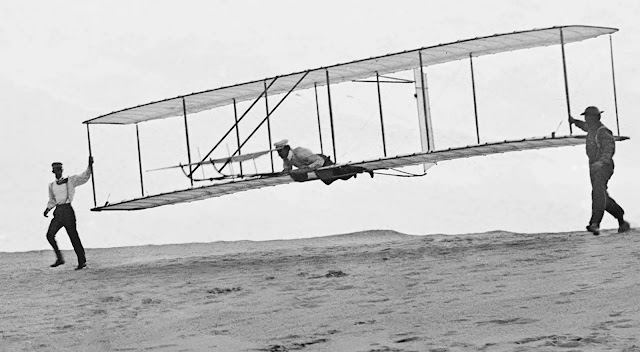After experimenting with kites and gliders, the brothers Orville and Wilbur Wright made their historic flight in an aeroplane on 17 December 1903 near Kitty Hawk in North Carolina. It lasted less than a minute but news of the flight resulted in worldwide interest in aeroplanes and the desire to fly.
Wright Brothers 1903 flight
There is undated film of Wilbur Wright on Pathe News.
This was particularly the case in France and several Frenchmen soon became leading aviators. In July 1909 Louis Blériot flew from Calais to Dover and won the £1,000 Daily Mail prize for the first English Channel crossing by an aircraft.
French illustration of the Channel crossing
Lord Northcliffe the owner of the paper, had been very impressed when he met Wilbur Wright during his demonstrations in France the previous year, and set up the prize. There is a local connection as Alfred Harmsworth had lived in West Hampstead before he achieved major success with newspapers and became Lord Northcliffe.
Louis Blériot
To capitalize on his fame, Blériot set up a flying school in Pau in the south of France. Englishman Claude Grahame-White learned to fly there and became friends with Blériot. They established a flying school in Colindale Hendon where Grahame-White had acquired 207 acres of farmland to form the London Aerodrome in 1911.
One of the early students at the Blériot school in Hendon was Francois Hanot who started training on 10 August 1911. He paid his tuition fee of £50 plus £40 deposit which would have been returned at the end of the course. Hanot found lodgings with a local policeman Augustus Cooper at 30 Annesley Avenue.
Having begun the course, Hanot made slower progress than he anticipated and was frustrated by having to attend classes in the theory of flying. He resented the advice from mechanics about safety, saying he knew what flying was all about. At the end of the first week, with his instructor he managed to fly a plane in a circuit around the aerodrome, but he was still angry particularly with the chief instructor Paul Maurice Petitpierre.
In the early evening of Saturday 19 August, the well-known French flyer Gustaf Hamel, had taken off in front of a large crowd to fly from Hendon to Southend. That day Hanot approached Norbet Chereau the manager of the school and demanded his money back. He said he had not received the training he expected and demanded a full refund of his £90 (worth about £9,800 today). Chereau said this was impossible and they were joined by other people from the flying school, including M. Petitpierre who supported his manager. At this point, Hanot seemed to calm down and even shook hands with the instructor. Then they waited with the rest of the crowd watching the planes taking off.
M. Chereau left, and M. Petitpierre right
As people began to leave, Hanot suddenly pulled out a Mauser automatic pistol and opened fire. He missed Chereau but one bullet hit Petitpierre in the thigh. People tried to restrain Hanot but he managed to get free and fired three shots into his chest. A doctor from the crowd helped both the wounded men who lay covered with blankets on the ground. Still conscious, Hanot was asked why he had done it. He replied: ‘M. Chereau owes me £90 and will not pay me’. He said he had no friends and asked that the £25 in his pocket book and his gold watch be given to PC Cooper.
While they waited to be taken to hospital, Hanot pulled a razor from his pocket and gashed himself deeply in the throat. He was taken to St Mary’s Hospital in Paddington where he died shortly after one o’clock the following afternoon. Petitpierre was initially transported by motor car to the nearby Hendon Sick Asylum in Colindale, and then he was also taken to St Mary’s where he died an hour after Hanot.
The inquest was held the following week. M. Chereau said that Hanot had written a letter to him on Friday saying they were not teaching him properly and criticised Petitpierre. The following day Hanot came to his office and Chereau told him he had read the letter, and they had done everything to make him a proficient flyer. Hanot said, ‘You won’t return me my money then?’ Chereau said ‘No, that would be unreasonable, as you have no serious complaint’. The discussion lasted about 15 minutes and Hanot seemed to take a reasonable view of the matter. Then Chereau, Petitpierre and Hanot joined the crowd on the airfield where the shooting took place without any warning.
In his evidence Detective Inspector Henry Brooks said he had searched Hanot’s room in PC Cooper’s house. He found cartridges for the gun, and Hanot’s passport that showed he was aged 34 and born in Calais. Letters indicated that he was a language teacher. But enquires failed to find any relatives.
PC Cooper said that Hanot was quiet and gentlemanly, and when he arrived at his house on 9 August he said he had come from France.
Fellow students at the flying school expressed complete satisfaction with the instruction they received from M. Petitpierre. One said that Hanot appeared to be anxious to fly after just two days tuition.
The jury verdict was that Hanot had murdered Petitpierre and then committed suicide.
Paul Maurice Petitpierre aged 31, was buried at Hendon Cemetery, Mill Hill on 24 August. A floral wreath in the shape of an aeroplane was given by the staff and students of the Flying School. Francois Augustin Hanot was buried without ceremony the following day.
This sad story has no further explanation beyond the fact that Hanot was a lonely man who was desperate to fly and wanted his money back because he believed he had not been well taught.
1933 Map showing part of Hendon Aerodrome at the top

%20(1).JPG)
.jpg)


Comments
Post a Comment